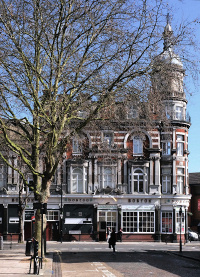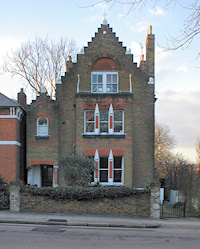Tufnell Park
Tufnell Park, Islington
A distinctive 19th-century residential scheme, characterised by wide, tree-lined streets and individually styled housing, situated north-east of Kentish Town

From early times this was part of the manor of Barnsbury, which in the 15th century possessed a moated farmhouse at what is now the eastern end of Tufnell Park Road.
William Tufnell inherited the manor in 1754 and soon afterwards changed his surname to Jolliffe. The estate later passed to his brother and down through his family, thus regaining the Tufnell connection.
The area was known for its dairy farms until the early 19th century but in 1822 the Tufnells sought permission to grant building leases and created Tufnell Park Road two years later. Other roads were named after branches of the extended family.
The manor’s brick and stone gateposts survive on either side of Tufnell Park Road, just east of the junction with Lady Margaret Road. They’re very favourably reviewed on Google Maps.
Most of the terraced houses were built in the 1850s and 1860s, often with separate gabled roofs to make them look like semi-detached houses. Only two architects were employed throughout the project but they built adventurously, differentiating each street and sometimes every villa within a street. Façades were often plain but imaginatively ornamented, especially around the windows. Many of the surviving houses are now locally listed but only numbers 9 to 21 Tufnell Park Road have statutory protection.
The Byzantine-style church of St George was included as part of the development project and was endowed for the Free Church of England in 1868. Its adjacent Rhenish tower was built in 1875.
Shown in the photo above, the Boston Arms is a grade II listed public house and music venue, designed by pub specialists Thorpe and Furniss, who tended to build in whatever style, or mix of styles, the landlord desired. Traditionally favoured by the local Irish community, the Boston is dated 1899 in a panel on its Junction Road front.

Tufnell Park station opened in 1907 on the newly built Charing Cross, Euston & Hampstead Railway, which initially terminated at Archway (then called Highgate).
As in much of Victorian north London, the 20th century brought the subdivision of many of the houses and municipal replacement of others, so that most of Tufnell Park’s residents now live in flats, rented privately or from the council or housing associations.
More recently, some houses have been reunited as the wealthier middle classes have recolonised the locality, especially on the western side.
A new church of St George (now St George and All Saints) was built at the corner of Crayford and Carleton Roads in 1974. The old church served as a Shakespearean theatre in the latter part of the 20th century and has since become the Rock Tower, which doubles as a Nigerian church and an events venue. Jeremy Corbyn held his final rally at this venue (which is in his constituency) before his election as leader of the Labour party in September 2015.
Channel 4’s Spaced (1999–2001, “the most influential comedy of this millennium”, The Guardian) was set at the fictional 23 Meteor Street (actually Carleton Road), Tufnell Park.
